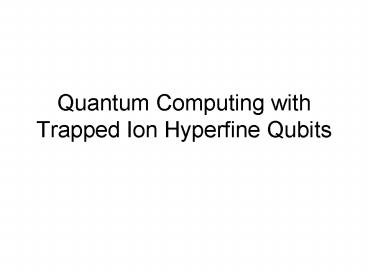Quantum Computing with Trapped Ion Hyperfine Qubits - PowerPoint PPT Presentation
1 / 16
Title:
Quantum Computing with Trapped Ion Hyperfine Qubits
Description:
Optical qubits - derived from ground state and an excited metastable state ... Penning trap: using a constant magnetic field and a constant electric field ... – PowerPoint PPT presentation
Number of Views:55
Avg rating:3.0/5.0
Title: Quantum Computing with Trapped Ion Hyperfine Qubits
1
Quantum Computing with Trapped Ion Hyperfine
Qubits
2
General requirements
- A scalable system of well-defined qubits
- A method to reliably initialize the quantum
system - Long coherence times
- Existence of universal gates
- An efficient measurement scheme
3
Type of qubits for trapped ion
- Optical qubits - derived from ground state and an
excited metastable state separated by an optical
frequency - Hyperfine qubits - derived from electronic
ground-state hyperfine levels separated by a
microwave frequency
4
Ion traps
- Quadrupole ion trap using DC and radio frequency
(RF) 1 MHz oscillating AC electric fields - Penning trap using a constant magnetic field and
a constant electric field
5
Ponderomotive pseudopotential
Oscillation frequency of ion
6
(No Transcript)
7
Trapped ion hyperfine qubits
- Electric field perturbations are small
- Magnetic field perturbations can be reduced by
coherence between two internal levels - Extremely long radioactive lifetime
8
?e
egt
9
Initialization and detection of qubits
- Standard optical pumping to initialize HF qubits
to either or - Polarized laser beam resonant with spacing level
scatter either or
10
(No Transcript)
11
HF Qubit Rotations Single Qubit Gates
- Microwave with frequency ?HF
- Big wavelength cm
- - good for joint rotations of all qubits
- - difficult for individual qubits rotation.
- Stimulated Raman Transitions (STR)
- - two laser fields with detuning ? from
excited state and differing in frequency by
?HF, ?gtgt?e - - SRT Rabi frequency OSRTg1g2/ ?
- - individual qubits rotation can be achieved
12
Interactions between HF qubits entangling qubit
gates
- Interaction Hamiltonian
- Motion-sensitive stimulated Raman transitions
- Spin-dependent optical forces
13
Motion-sensitive stimulated Raman transitions
Rotating wave approximation
14
k-1
J-C Hamiltonian
15
Spin-dependent optical forces
- Laser beams dipole force depends upon the state
of the qubit Sgt and certain excited state
(atomic selection rules). - Appropriate polarization of the light.
- Use intensity gradient of a laser beam or
standing wave to control the motion of ion.
16
With an intensity gradient (focusing or standing
wave)

